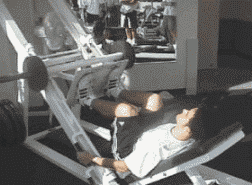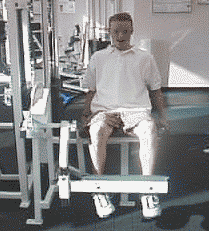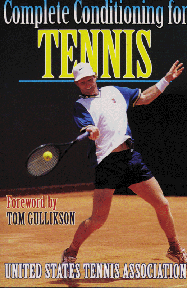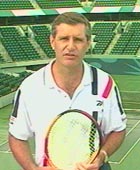Periodization Training for Tennis
Part 6
By Dr. Paul Roetert
Strength Training
Tennis is a rapid, dynamic sport that requires powerful, repeated muscle contractions. For this reason our approach to tennis conditioning uses dynamic strength training. This includes the use of free weights, such as dumbbells and barbells, medicine balls, and weight training machines. Tennis specific strength training does not involve heavy effort to lift maximum weight. It uses light to moderate resistance levels with high repetitions designed to build strength and muscle endurance, not bulk or size.
Some players believe that resistance training can cause stiffness and loss of flexibility, but the program outlined here--combined with the flexibility exercises in the previous articles--will actually increase flexibility, optimize performance, and prevent injury. The program is based on the bio-mechanical analysis of stroke patterns. This allows us to tailor exercises specifically for tennis players. In all exercises, it is important to emphasize slow, controlled movement. This means using the muscles in all phases of the movement, similar to the way muscles work in actual play.
Start the program doing sets with higher repetitions, in the 10-15 range. As you move through the stages of training, increase the weight, drop the number of repetitions, and try to increase the number of sets. Remember, strength training is progressive. When you complete a set you should feel muscle fatigue. If you don't, that's the signal to increase weight or repetitions.
Rest cycles between sets of the various exercises in this program should match the duration of the rest period in an actual tennis match. One set should be followed by followed by 25 to 30 seconds rest, the average time between points in match play. One final point, don't lift immediately before you play! Train on days when your workouts are lights, and lift weights following your on court work.
This article and the next will outline the strength training exercises for the lower body. This article covers machine exercises, and the next one free weights. After that we'll present the exercises for the trunk area, including the abdominals. Next we'll present the rotator cuff and shoulder strength training program, then other upper body exercises. Finally, we'll move on to the forearm and the wrist.
The result will be the same personal periodization training used by top American junior and professional players, a program designed so that your play will "peak" in competition! Remember, just following this program can increase your level of play significantly without any other changes in your game. So get to work!
Lower Body Machine Exercises
 |
Leg Press
Focus: Multiple-joint training exercise that works the gluteus, quadriceps, hamstrings, and calves.
Starting Position: Start with hips and knees bent at about 90 degrees, and feet shoulder-width apart.
Exercise: Straighten the knees and hips into the platform until they are almost completely straight. Slowly return to starting position. Do not lock knees.
 |
Leg Extension
Focus: Single joint exercise for quadriceps strengthening.
Starting Position: Sit on the machine adjusting the back rest so the center of your knee is in line with the weight's rotating axis. The lower pad should be just above your ankle.
Exercise: Extend your legs upward against the resistance, but don't hyper extend them. Slowly lower the weight to the starting position.
 |
Ham String Curl
Focus: Single-joint exercise that primarily works the hamstrings.
Starting Position: Lie on your stomach. The pad should hit on the lower third of your calf, just above the ankle.
Exercise: Slowly curl your feet toward your buttocks. Then slowly return weight to the starting position. Do not hyperextend your knees in the starting position.
Multi Hip
Focus: An important exercise that works the stabilizing muscles around the hip and groin.
 |
Hip Adduction
Starting Position: Face the machine and adjust the height of the platform so the machine's axis is aligned with the front of your hip. Adjust the bar to a 45degree angle, with your leg on the outside of the pad.
Exercise: Bring you leg across your body. Now, controlling the weight, return it slowly to the starting position.





